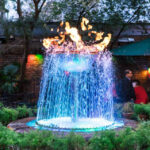Kensington Avenue, and the surrounding streets, had long been a place where capturing honest street photography felt fraught with unease. Early experiences in the neighborhood involved being photographed myself, my image circulated on social media, accompanied by damaging posts designed to undermine my presence and freedom to move safely within Kensington. Certain groups, self-proclaimed harm reduction advocates, seemed intent on spreading falsehoods, engaging in harassment, and using threatening language to drive me away.
Philadelphia, in many ways, operates with a degree of autonomy, with neighborhoods developing their own sets of rules and behaviors that diverge from broader societal norms. Kensington stands as a distinct world within this city, governed by raw emotion, a culture of abuse that has taken root and flourished, permeating every block, evident in daily interactions, and palpable in every moment. Accountability is often absent, creating an environment where harmful actions can occur with impunity. In such a setting, one is faced with a choice: acceptance or resistance.
While my time on Kensington Street has introduced me to extraordinary individuals – resilient and selfless people dedicating their time and energy to aiding those who have lost hope – honesty compels me to admit that these beacons of hope are few. There are indeed remarkable figures: nurses providing essential wound care, everyday citizens distributing packed lunches, and religious organizations conducting genuine outreach. Yet, these compassionate individuals are outnumbered by less altruistic forces. I have become adept at identifying systems and individuals driven by profit, and my approach moving forward is one of complete disengagement from such entities.
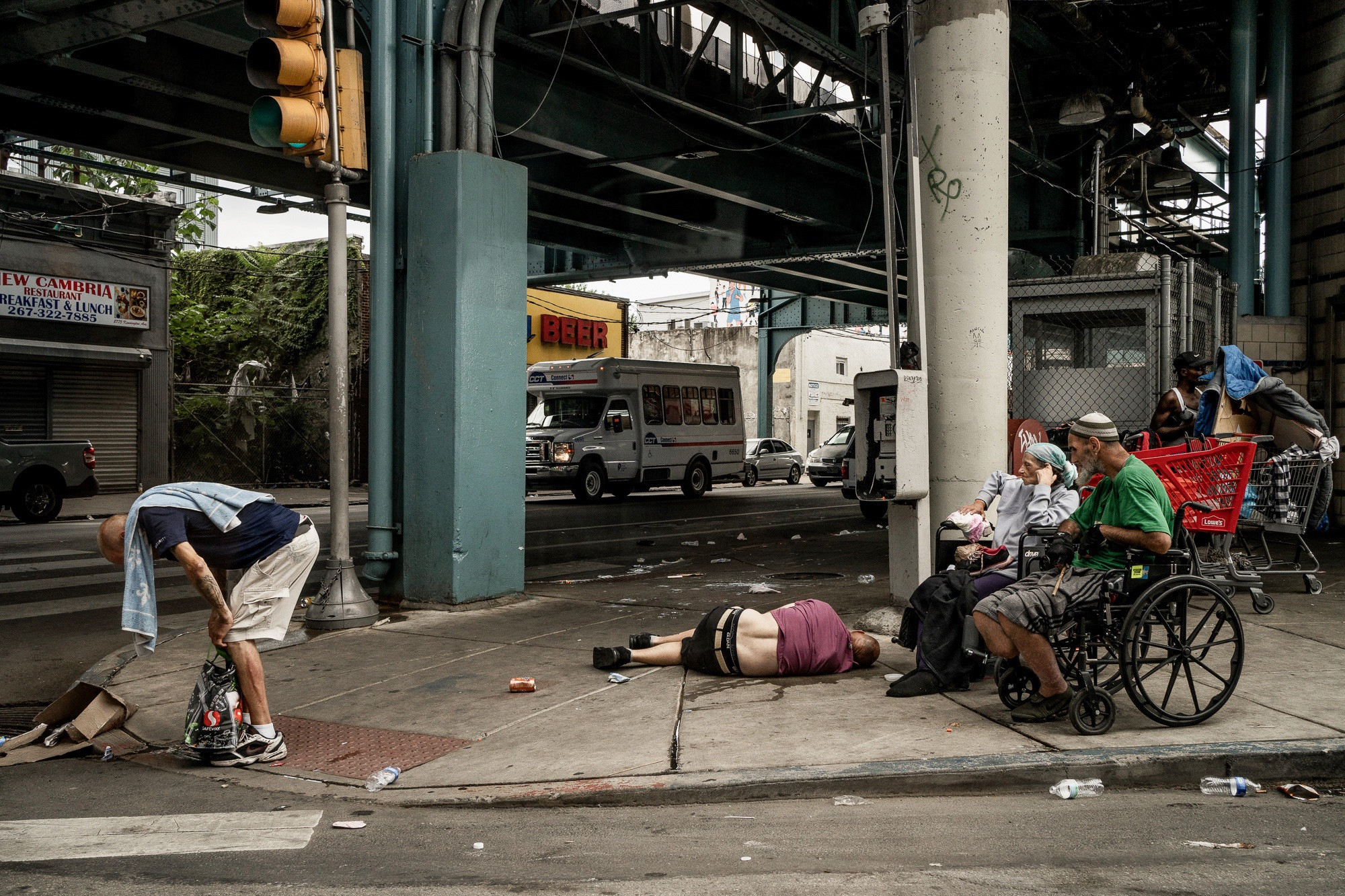 Street scene at the intersection of Kensington Avenue and Somerset Street, Philadelphia, depicting the raw reality of urban life.
Street scene at the intersection of Kensington Avenue and Somerset Street, Philadelphia, depicting the raw reality of urban life.
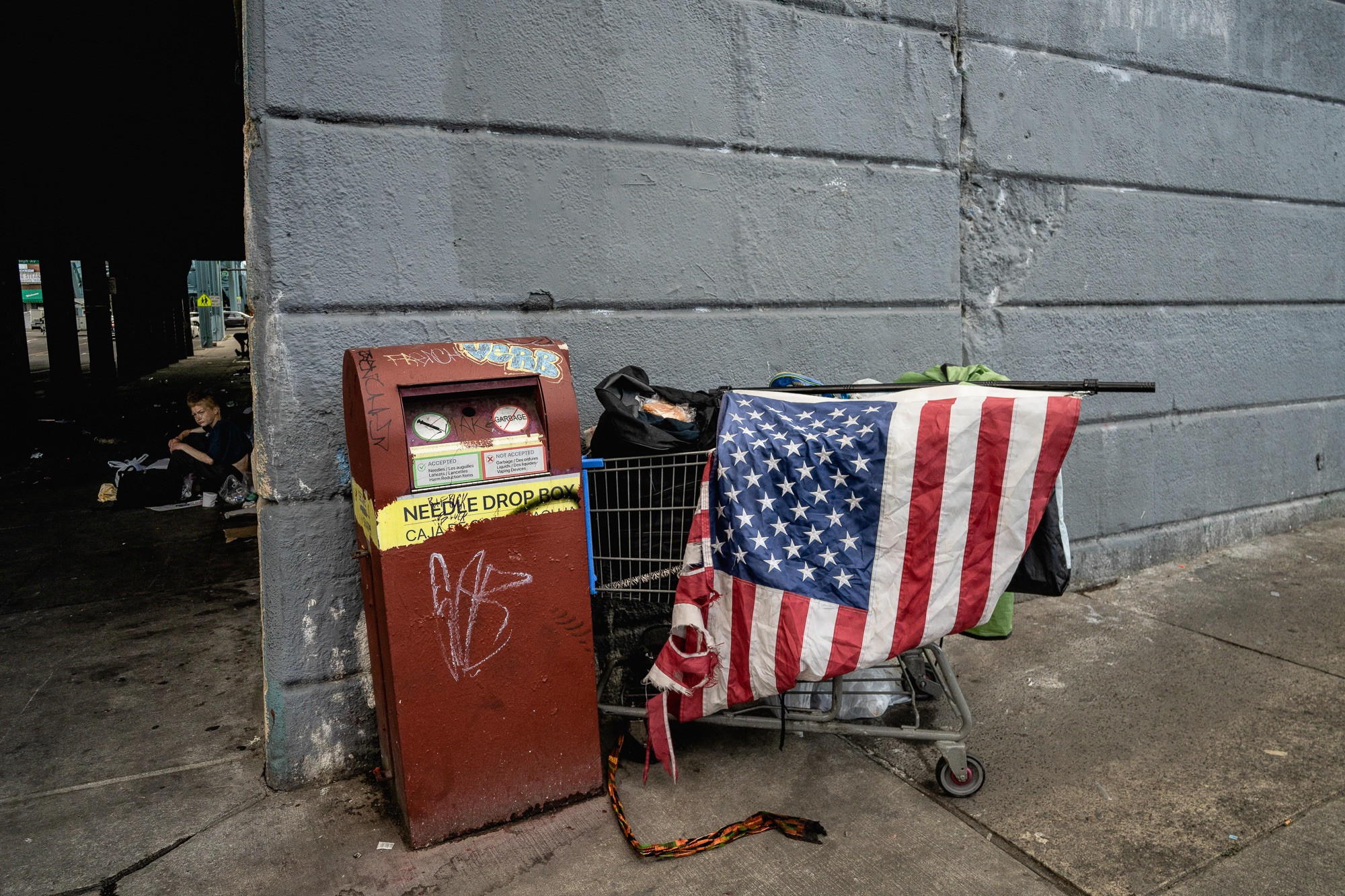 A street corner in Kensington, Philadelphia, at the junction of East Tusculum Street and Kensington Avenue, capturing the gritty atmosphere of the neighborhood.
A street corner in Kensington, Philadelphia, at the junction of East Tusculum Street and Kensington Avenue, capturing the gritty atmosphere of the neighborhood.
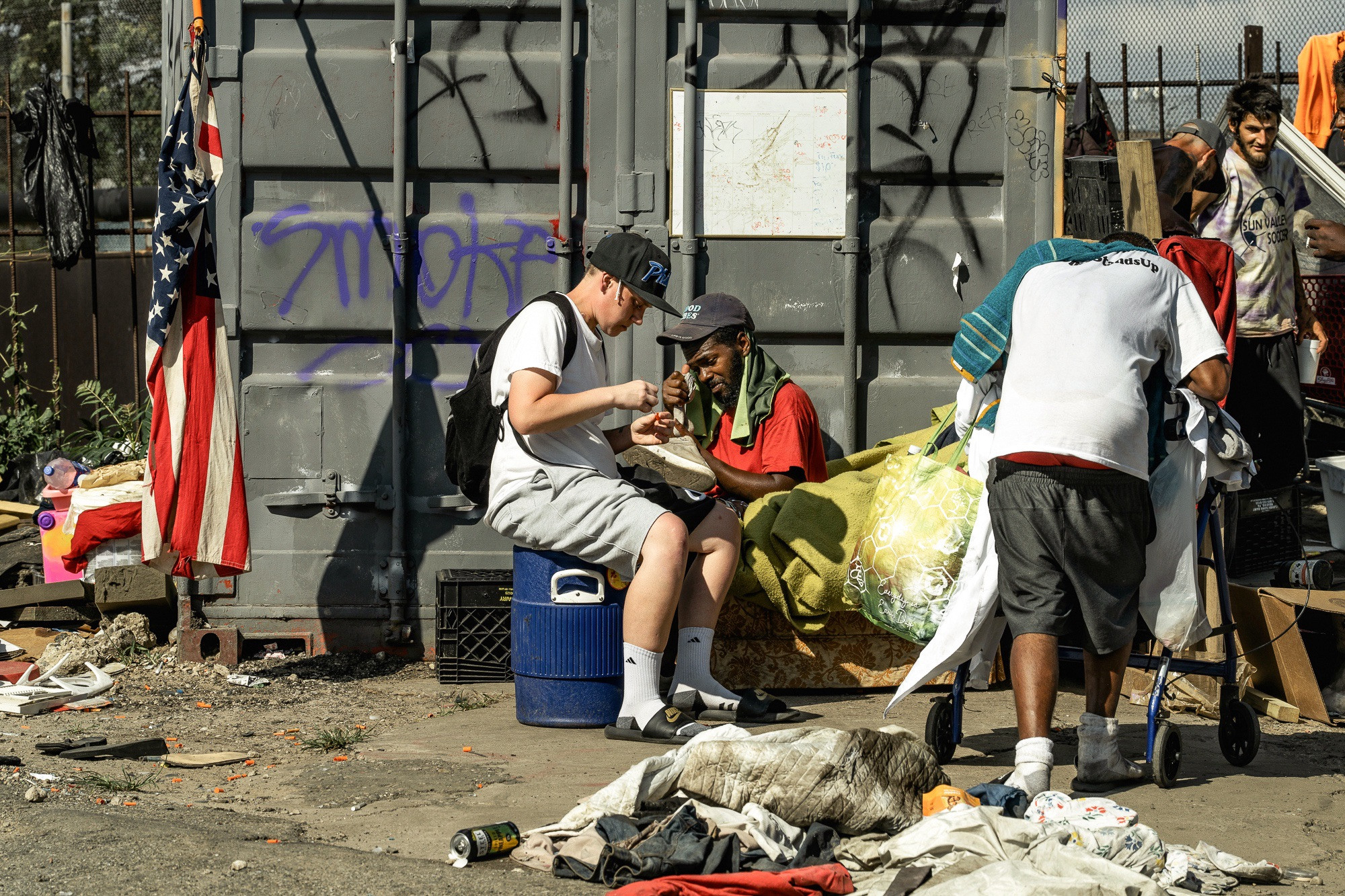 Urban decay and social issues are evident on East Gurney Street in Kensington, Philadelphia, highlighting the challenges faced by the community.
Urban decay and social issues are evident on East Gurney Street in Kensington, Philadelphia, highlighting the challenges faced by the community.
For months, I consciously suppressed my photographic instincts. I walked past countless scenes that vividly portrayed the story of Kensington, the pervasive issues of drug use, addiction, and profound neglect – a stark reflection of America itself. This is an American landscape scarred by the proliferation of smoke shops and the grim reality of tranq wounds, littered with discarded needles and Dunkin’ Donuts bags – a nation grappling with the devastating consequences of addiction. It’s a hidden landscape, brutally honest, raw, and unsettling. This style of street photography and reportage stands in stark contrast to the often curated and idealized imagery that dominates social media and mainstream news outlets.
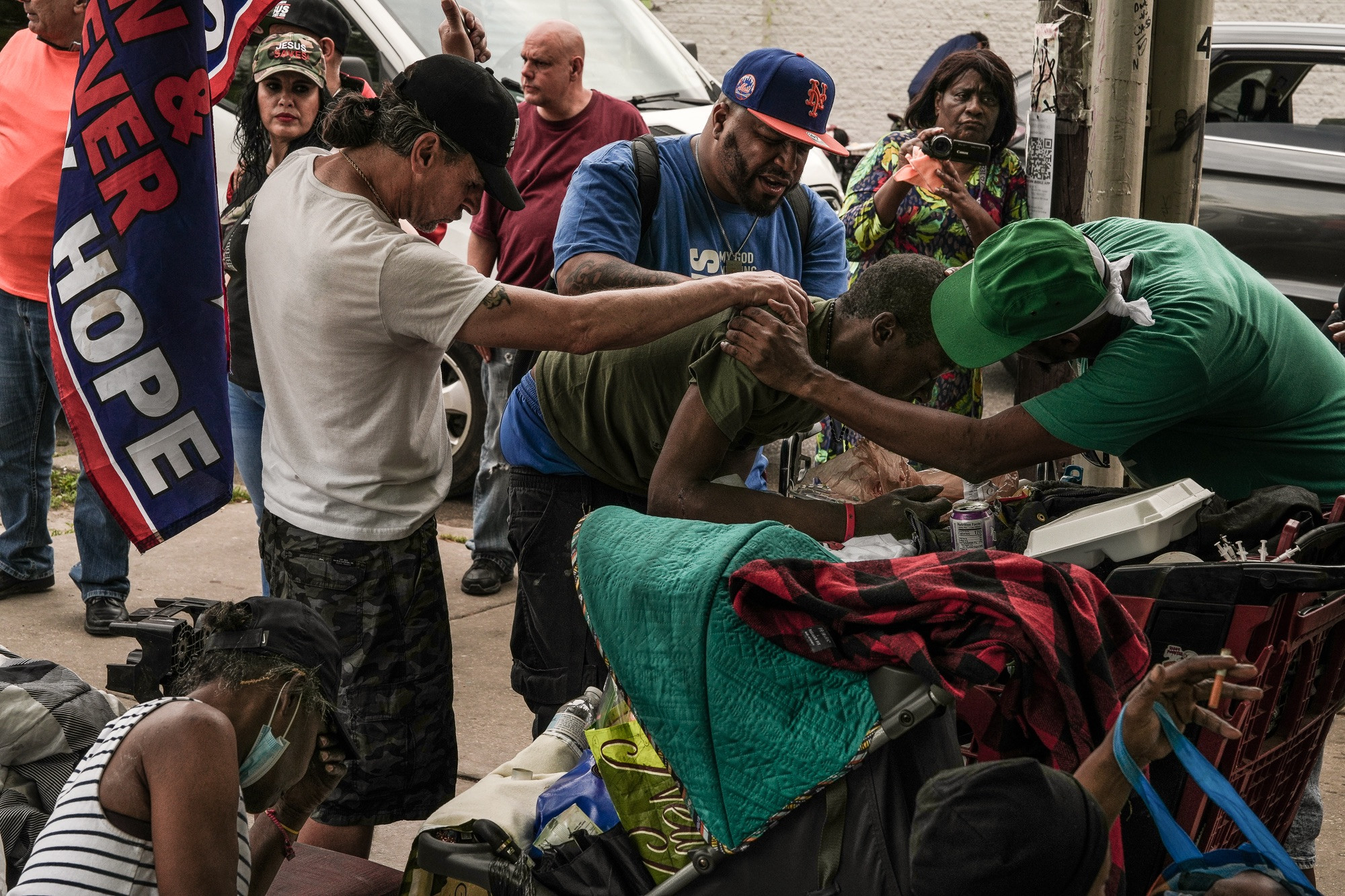 Former addicts offering prayer and support to individuals struggling with addiction in Kensington, Philadelphia, showcasing a glimmer of hope amidst hardship.
Former addicts offering prayer and support to individuals struggling with addiction in Kensington, Philadelphia, showcasing a glimmer of hope amidst hardship.
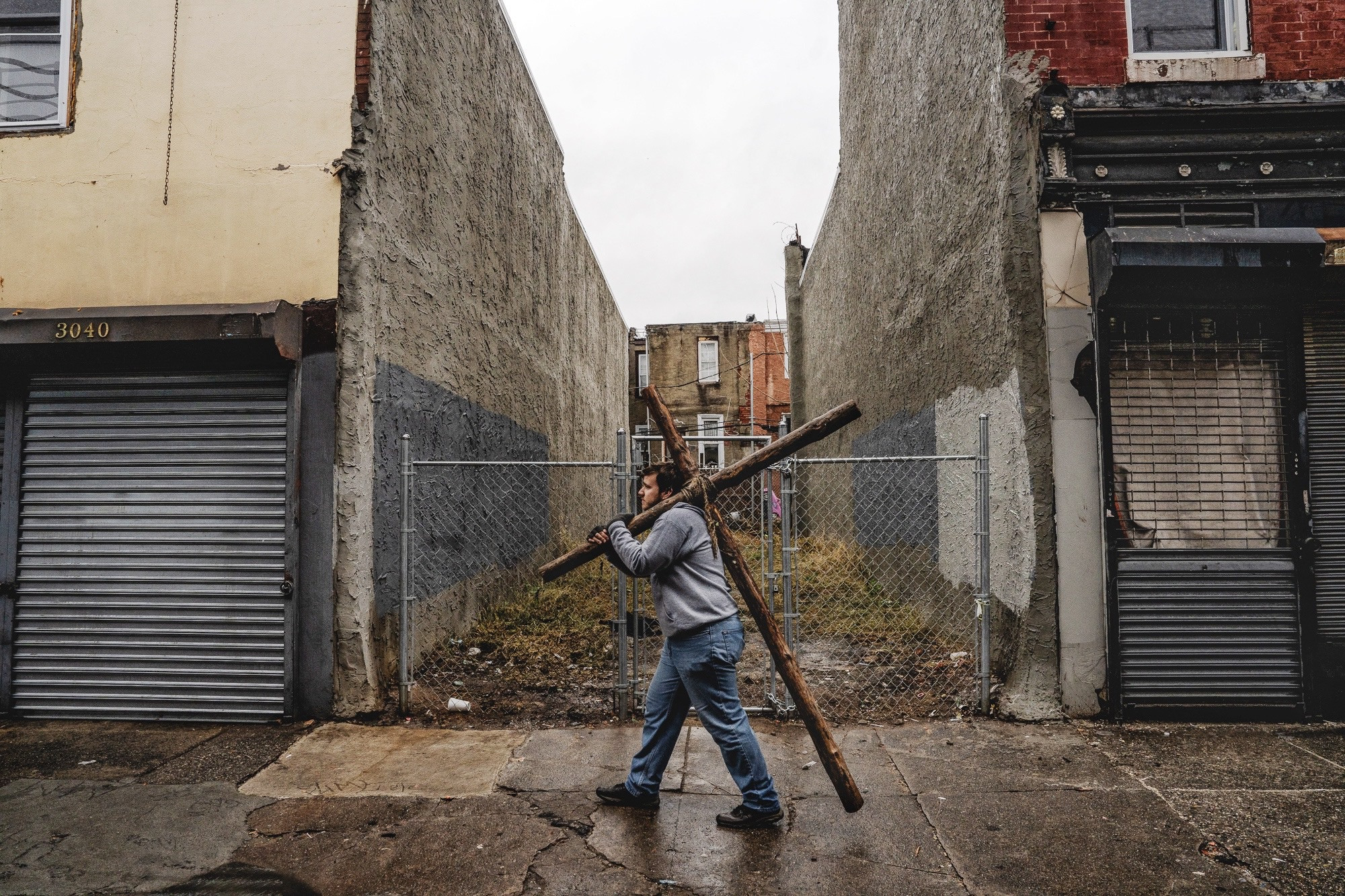 A moment of outreach and prayer on Kensington Avenue, Philadelphia, as individuals seek to connect with those in need of spiritual comfort.
A moment of outreach and prayer on Kensington Avenue, Philadelphia, as individuals seek to connect with those in need of spiritual comfort.
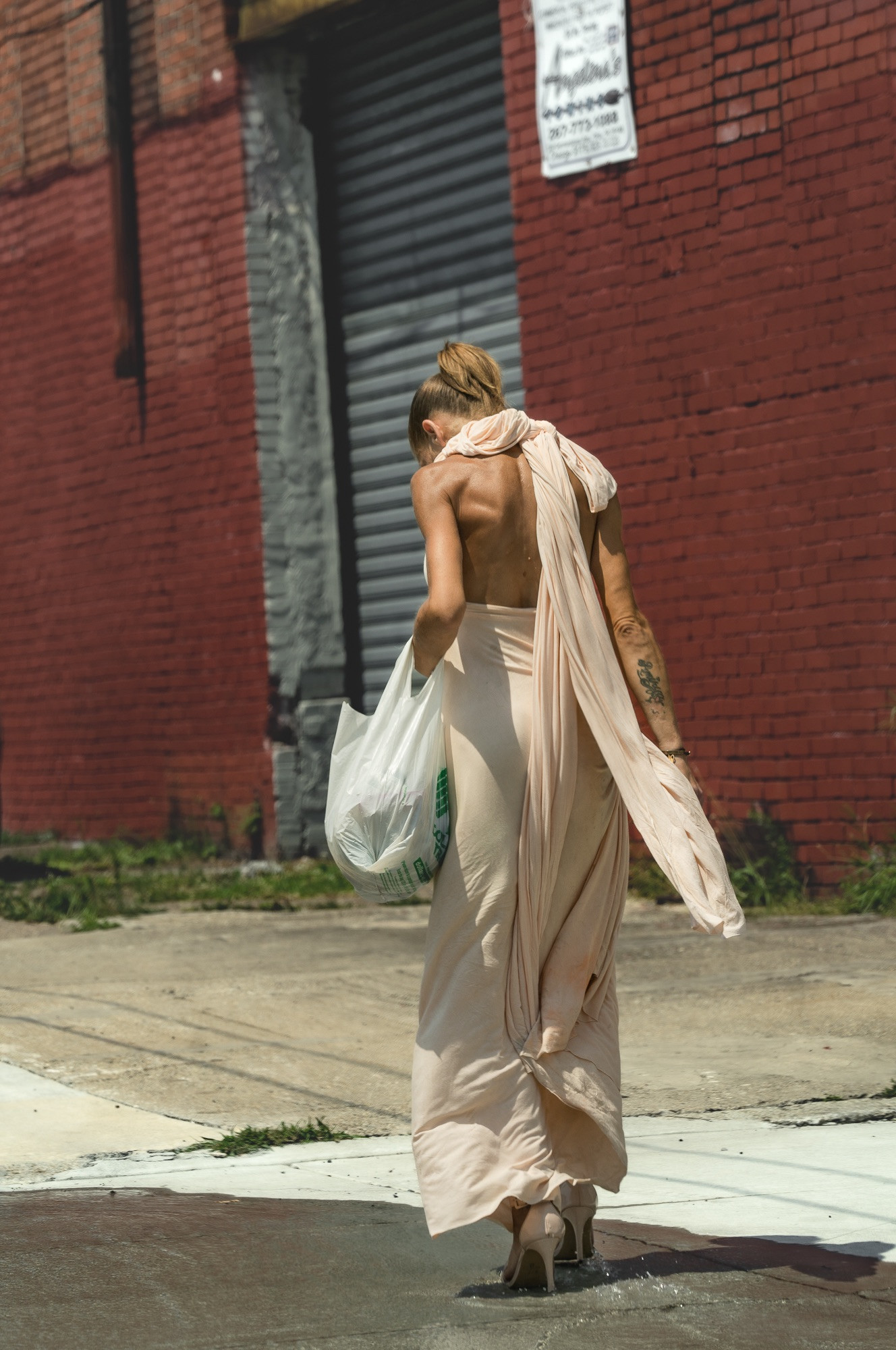 The intense heat of summer on East Lehigh Avenue in Kensington, Philadelphia, underscoring the harsh living conditions in the area.
The intense heat of summer on East Lehigh Avenue in Kensington, Philadelphia, underscoring the harsh living conditions in the area.
The overwhelming pressure to avoid any perception of exploitation, even at the cost of documenting crucial narratives, led me to miss critical opportunities to capture images of the devastation, desperation, and daily life in this part of the United States – moments I can never reclaim. These lost scenes, sights that deserved to be witnessed despite their disturbing nature, are a permanent loss.
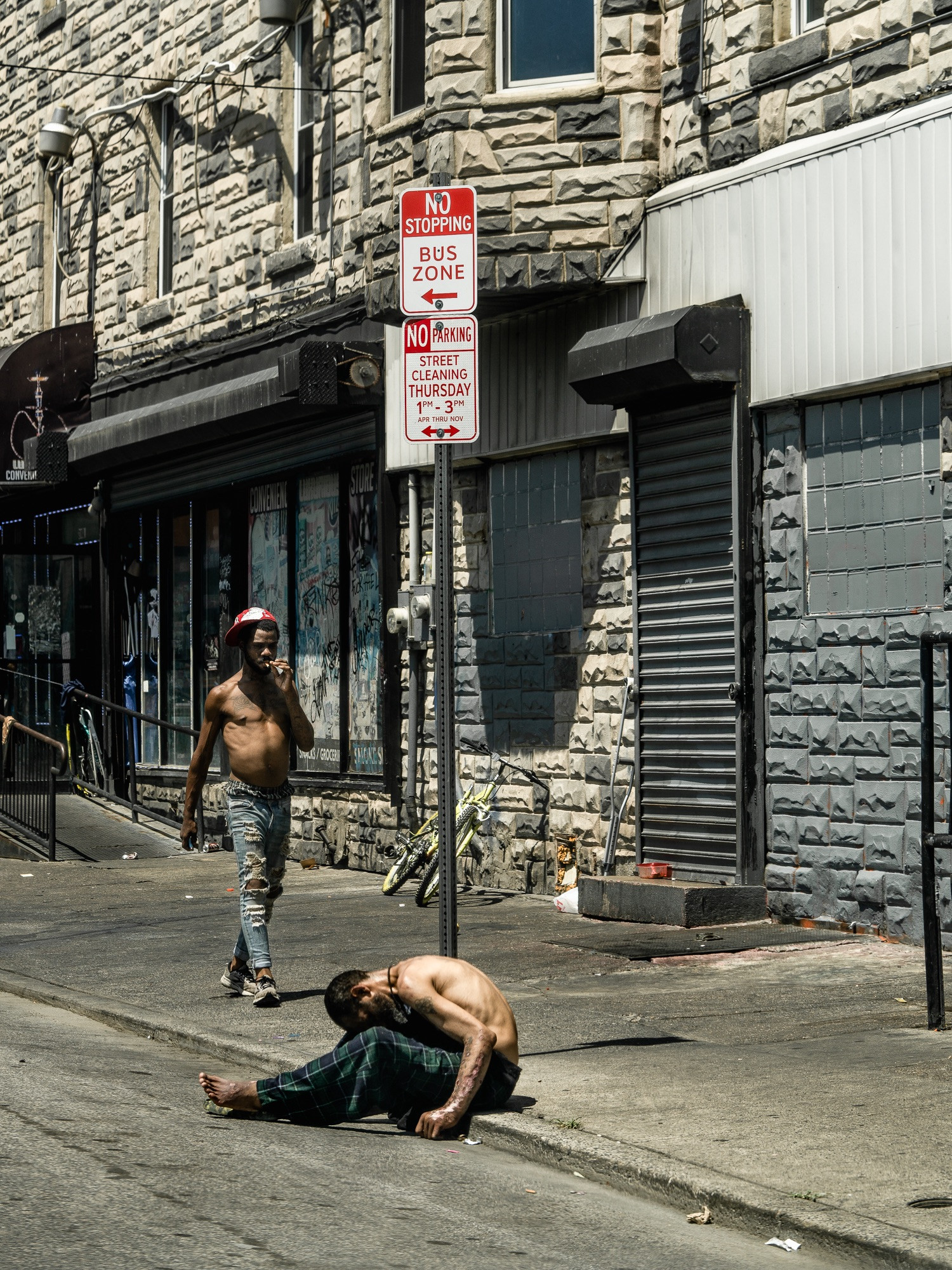 A poignant street scene on Somerset Street near Kensington Avenue, Philadelphia, essential for conveying the true message of Kensington to a wider audience.
A poignant street scene on Somerset Street near Kensington Avenue, Philadelphia, essential for conveying the true message of Kensington to a wider audience.
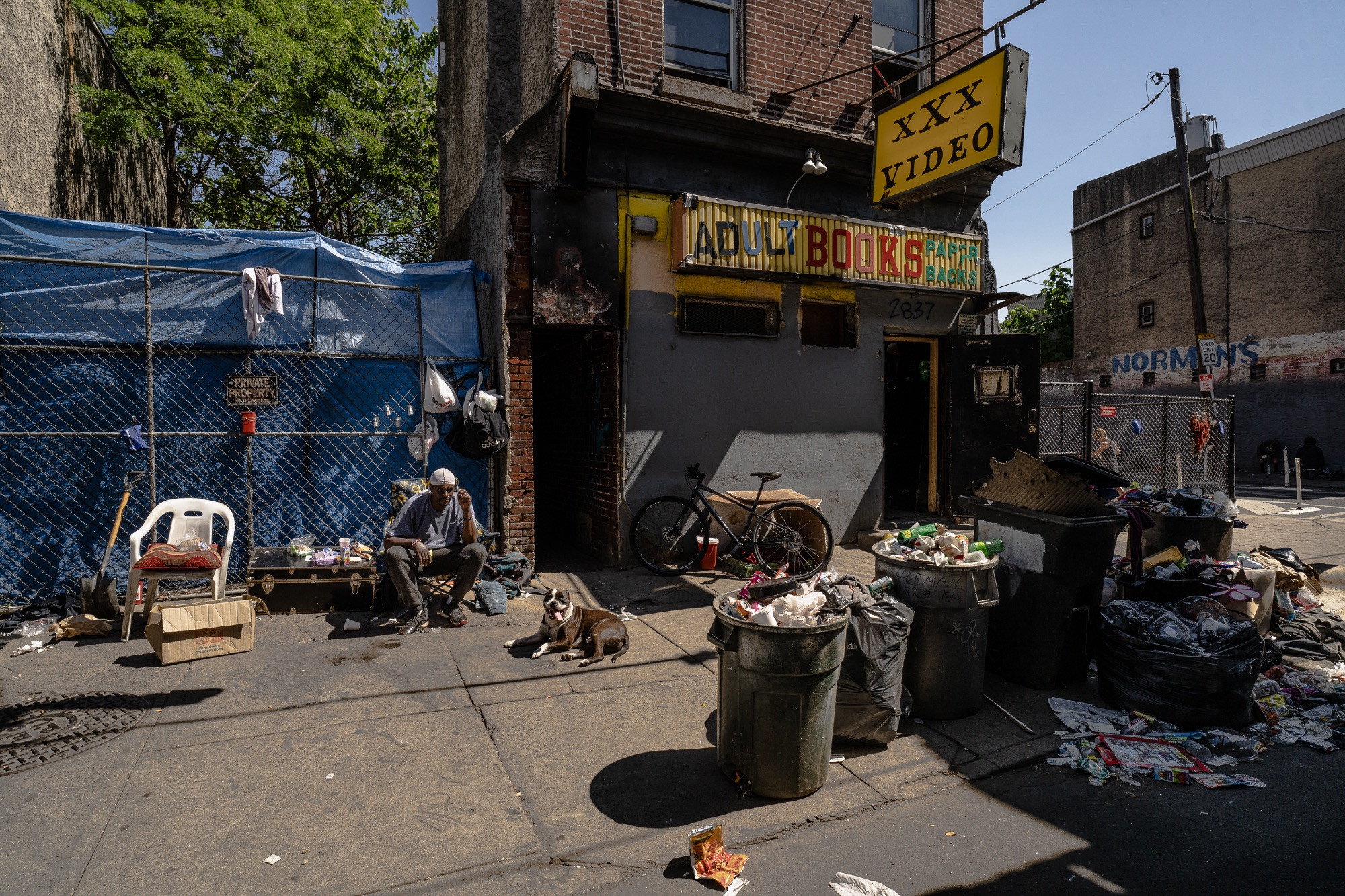 The remnants of the Adult Books storefront on Kensington Avenue, Philadelphia, formerly a hub for drug activity and exploitation, now demolished, symbolizing a complex history.
The remnants of the Adult Books storefront on Kensington Avenue, Philadelphia, formerly a hub for drug activity and exploitation, now demolished, symbolizing a complex history.
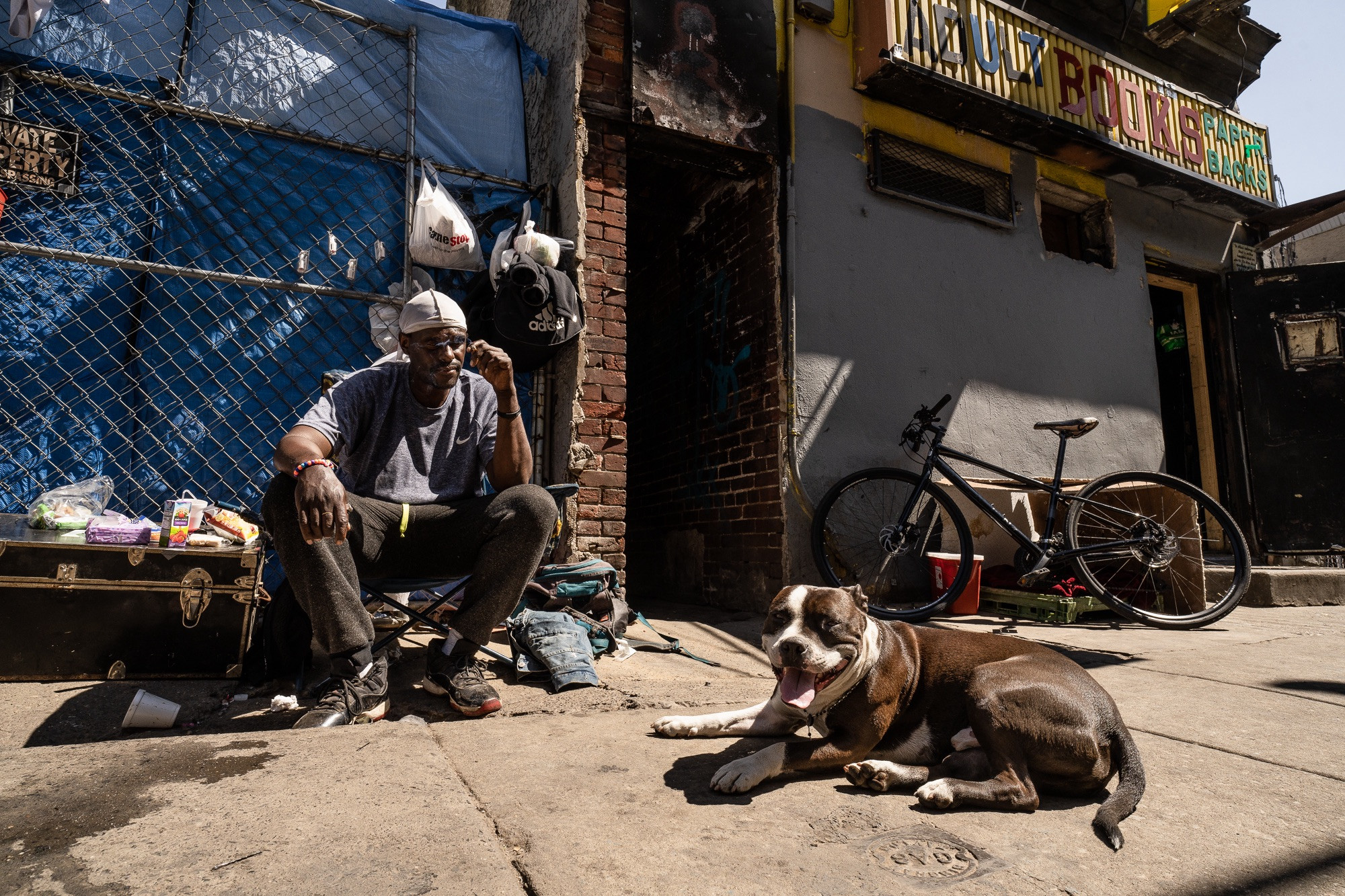 A closer view of individuals, Manny and Money, in front of the now-razed Adult Books building in Kensington, Philadelphia, capturing faces within the neighborhood's narrative.
A closer view of individuals, Manny and Money, in front of the now-razed Adult Books building in Kensington, Philadelphia, capturing faces within the neighborhood's narrative.
The paralyzing fear of being seen as exploitative hindered my ability to document, leaving a void in the visual record of this American crisis. I wrestled with the ethical tightrope, questioning where the line resided between documentation and exploitation, to the point where I almost lost sight of my purpose as a photographer in Kensington. The intense cultural pressure to conform, to align with prevailing narratives, to avoid causing offense, and the looming threat of being ostracized or professionally damaged, created a climate of self-censorship.
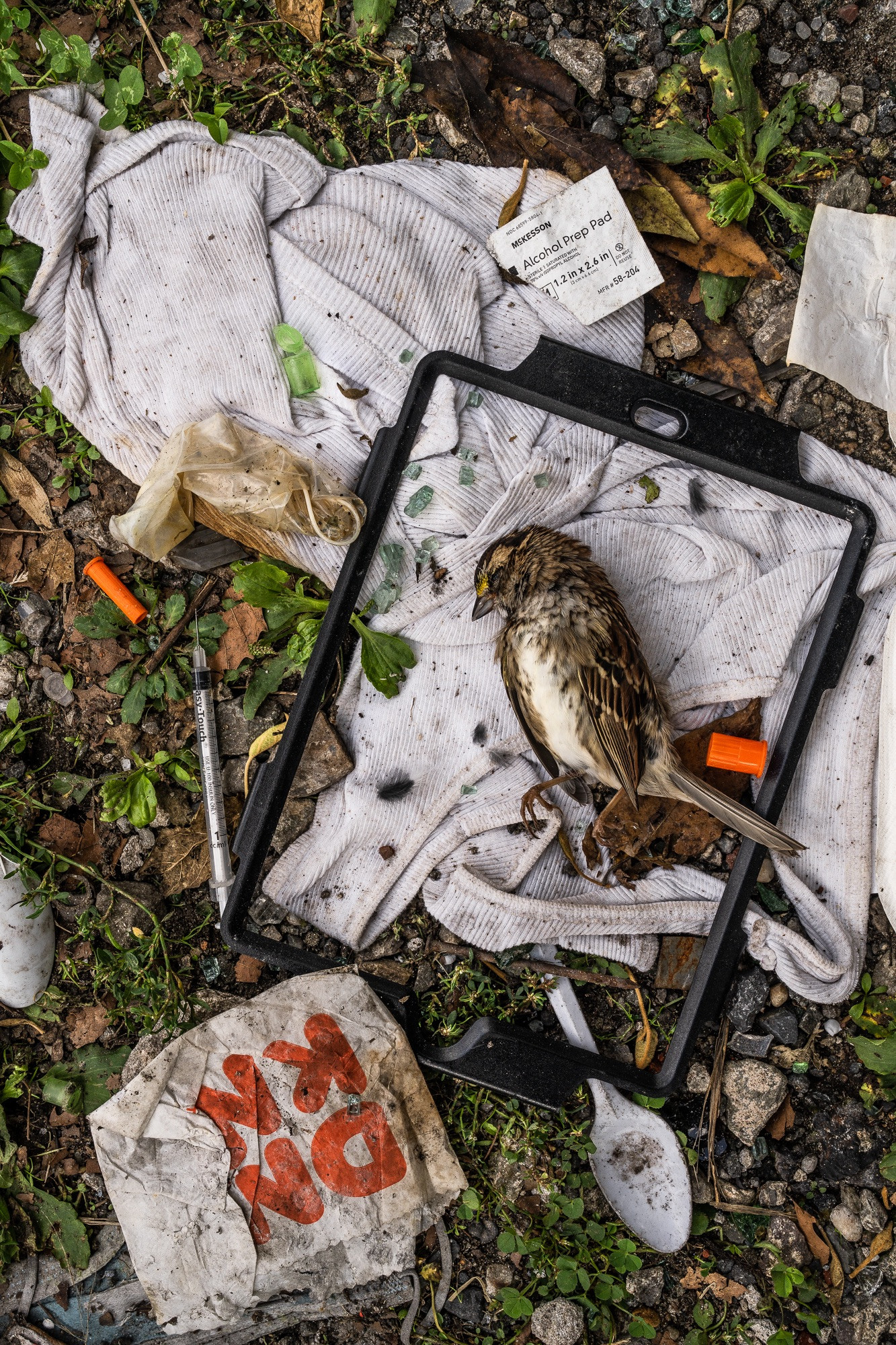 A still life scene on B Street in Kensington, Philadelphia, capturing the quiet moments amidst the urban chaos.
A still life scene on B Street in Kensington, Philadelphia, capturing the quiet moments amidst the urban chaos.
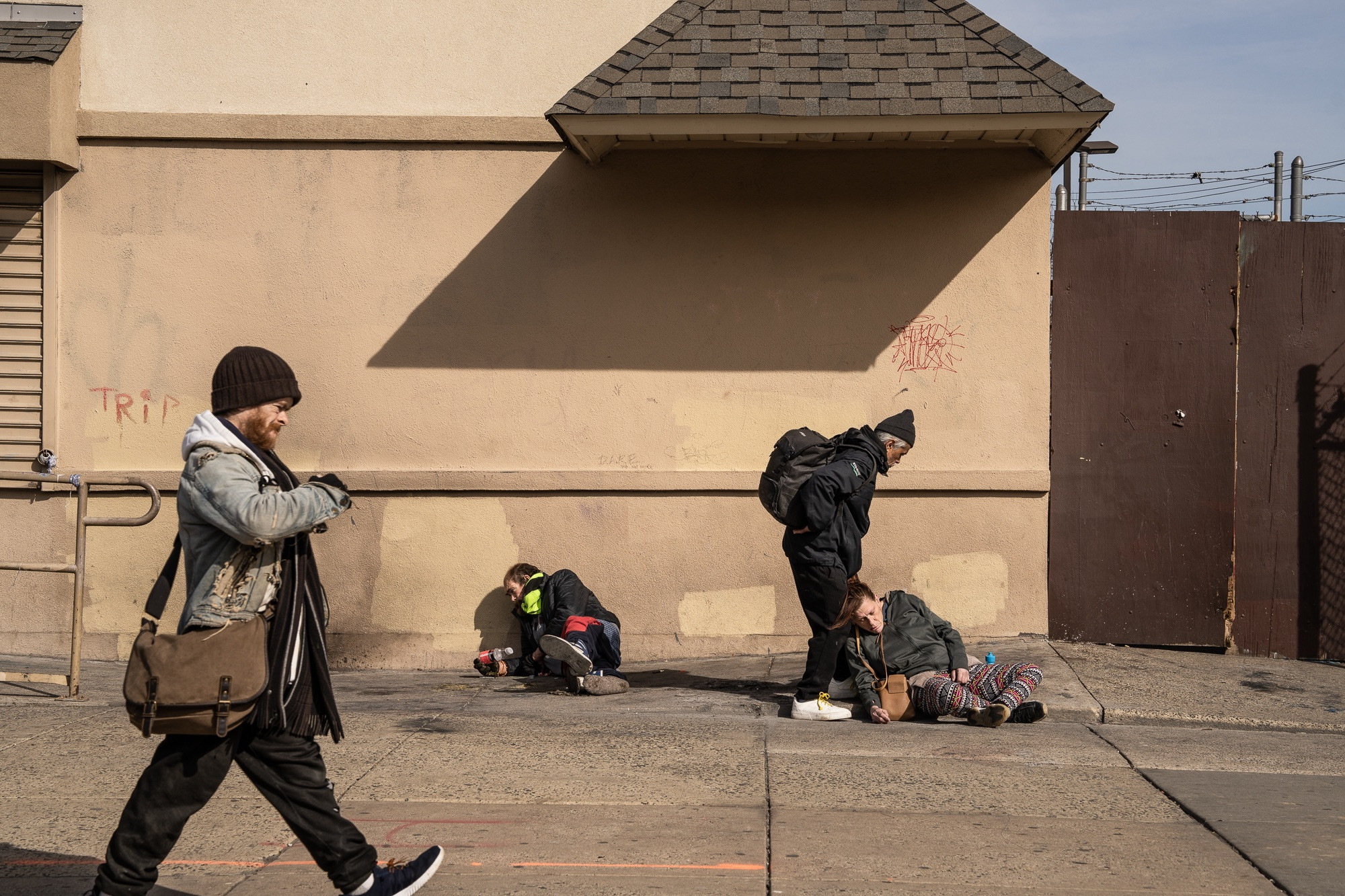 Another street view from Allegheny Avenue, Kensington, Philadelphia, depicting the urban landscape and everyday life.
Another street view from Allegheny Avenue, Kensington, Philadelphia, depicting the urban landscape and everyday life.
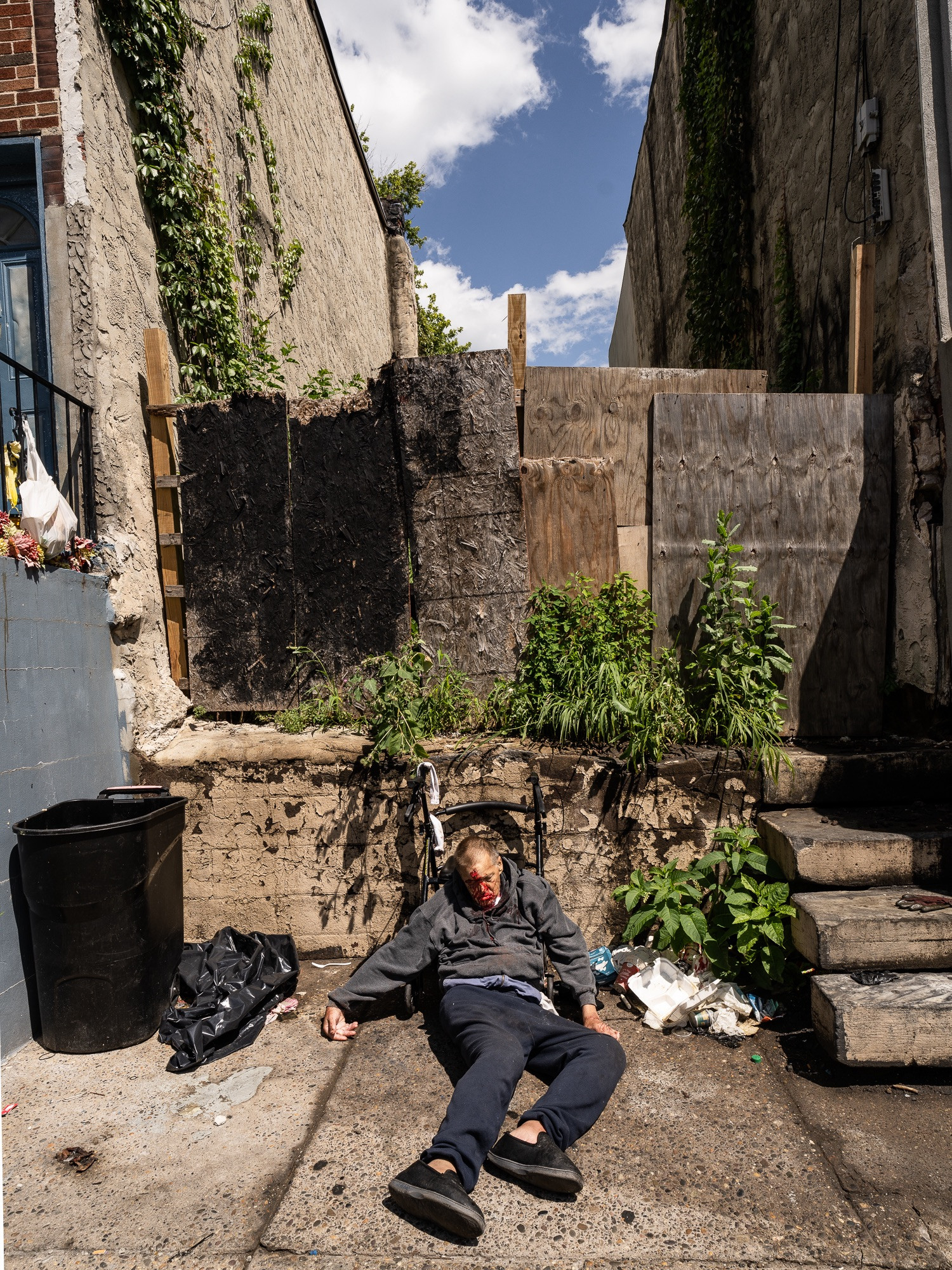 Street photography on C Street near E. Tusculum Street in Kensington, Philadelphia, focusing on the details of the urban environment.
Street photography on C Street near E. Tusculum Street in Kensington, Philadelphia, focusing on the details of the urban environment.
Not all photographic endeavors in places like Kensington are effective or ethical. Some are undeniably exploitative, made worse by poor execution, lacking technical skill, and, crucially, the absence of artful narrative perception. This raises a vital question: where is the ethical boundary? I grappled with this question so frequently that I nearly lost my way, forgetting the fundamental reason I was there with a camera in the first place.
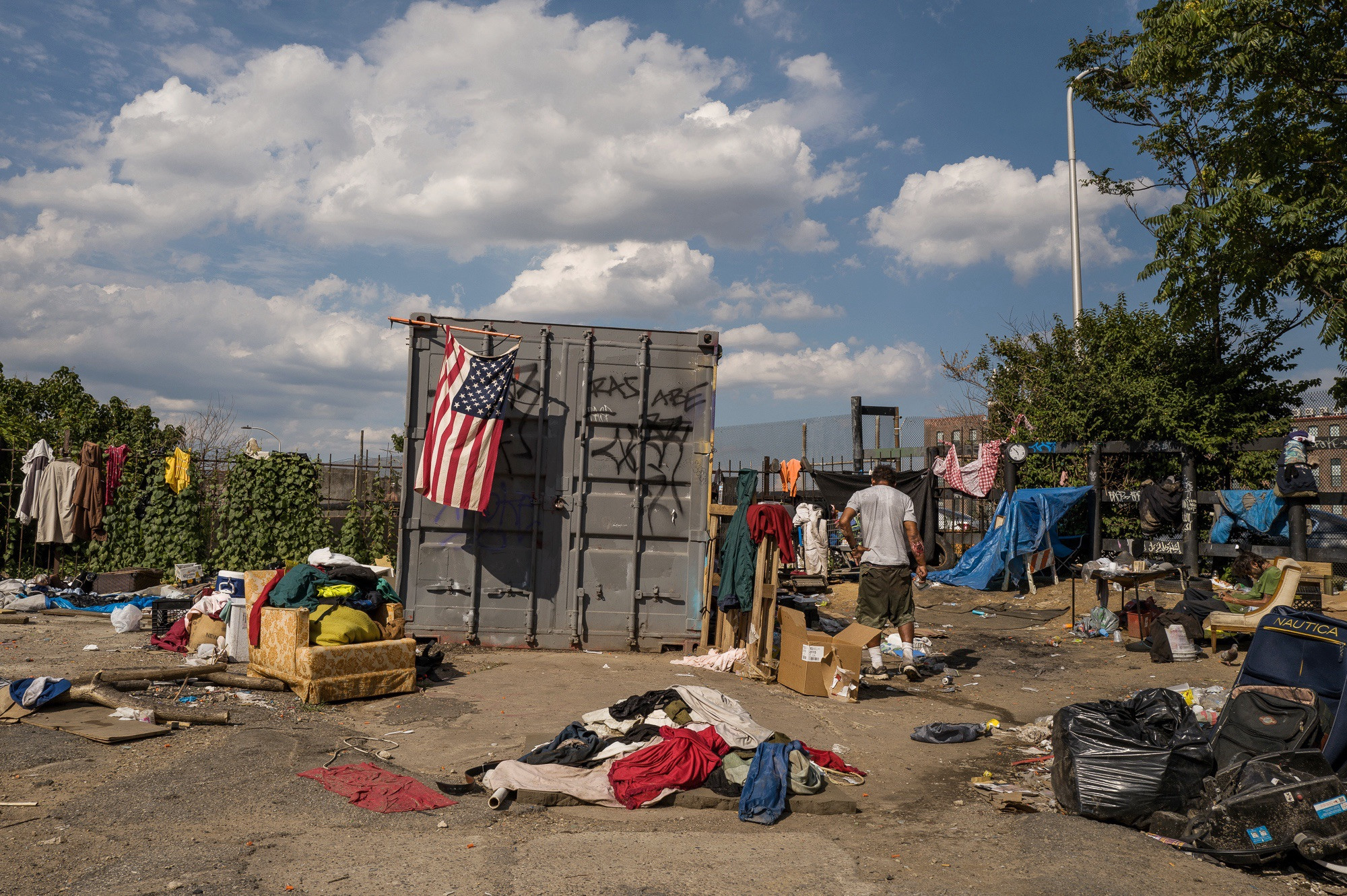 An American flag on East Gurney Street in Kensington, Philadelphia, telling a story of national challenges within a local context.
An American flag on East Gurney Street in Kensington, Philadelphia, telling a story of national challenges within a local context.
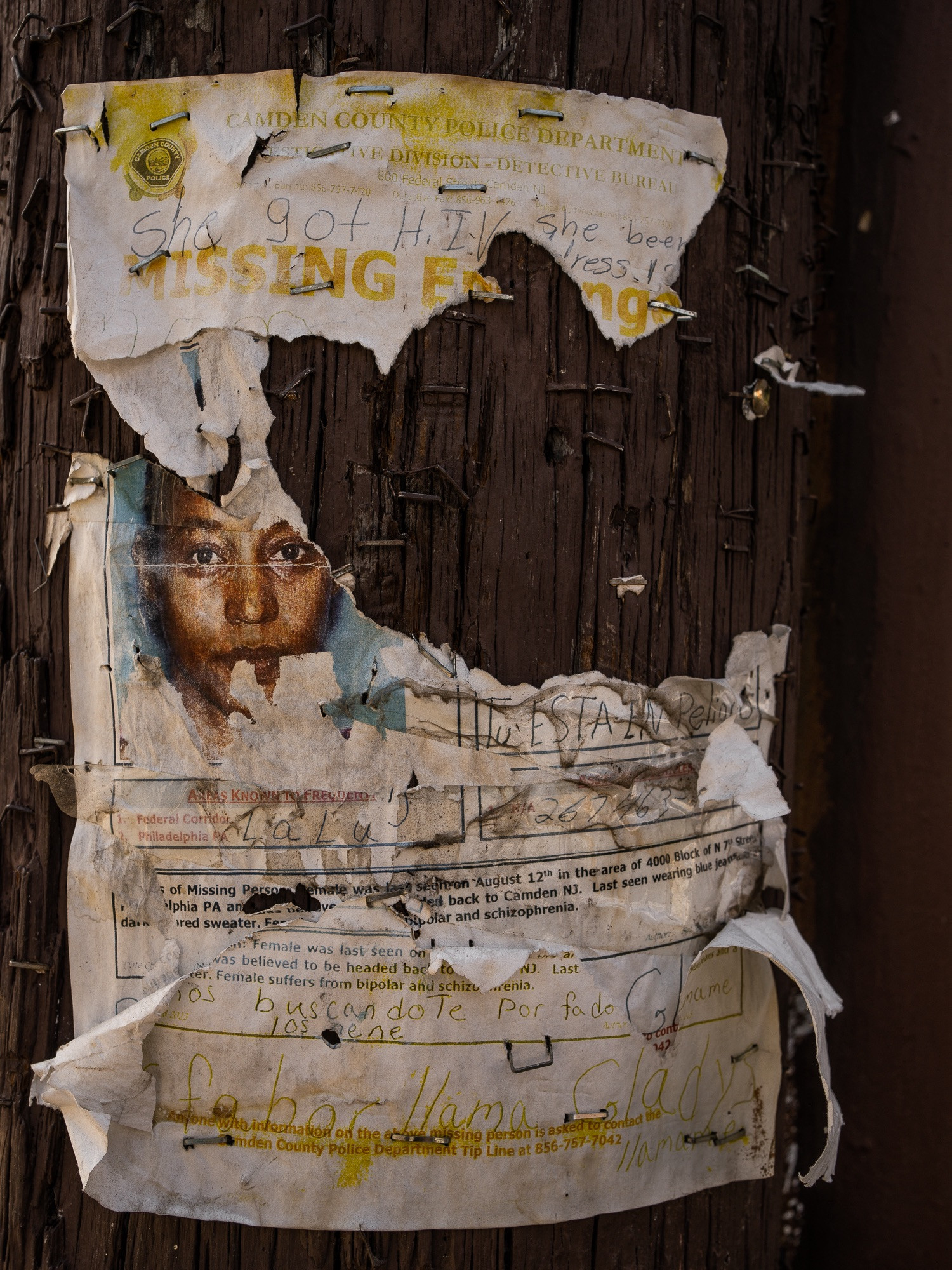 A missing person flyer in Needle/MacPherson Park, Kensington, Philadelphia, a somber reminder of the vulnerable individuals in the community.
A missing person flyer in Needle/MacPherson Park, Kensington, Philadelphia, a somber reminder of the vulnerable individuals in the community.
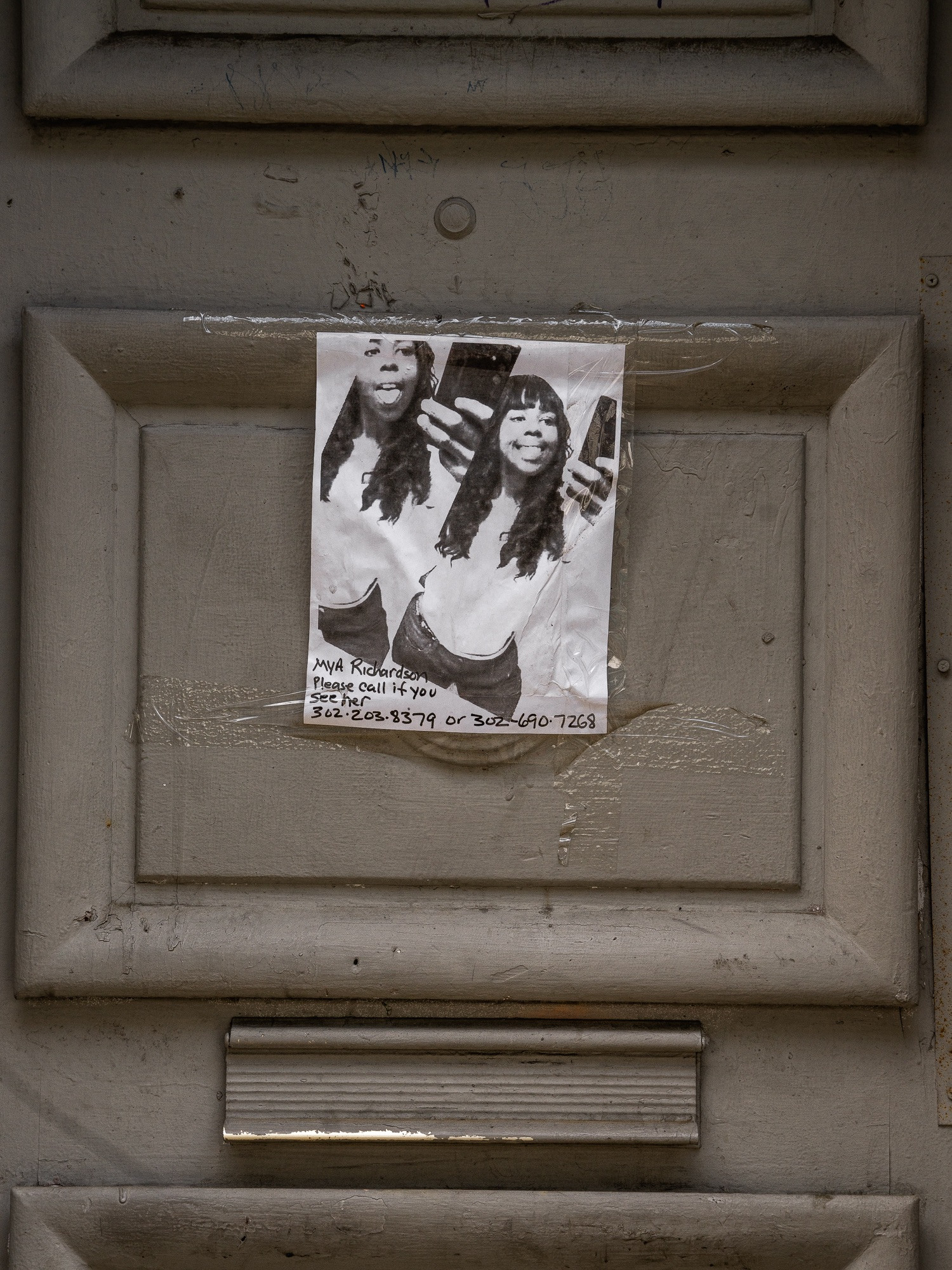 A missing person flyer posted on Kensington Avenue, Philadelphia, highlighting the issue of disappearances within the neighborhood.
A missing person flyer posted on Kensington Avenue, Philadelphia, highlighting the issue of disappearances within the neighborhood.
I found myself consciously avoiding stories that needed to be told. The constant thread of missing women in Kensington ran beneath the surface, women who were present one day and gone the next. Some were taken into custody, others simply vanished from the streets they had inhabited for months. Certain images I hesitated to share, struggling to find my voice, feeling silenced by external pressures. Sometimes, I chose not to take the picture at all, succumbing to a self-imposed silence, pressured to overlook the harsh realities. Editors at major publications seemed hesitant to engage with my images and their implications, contributing to a pervasive sense of unworthiness. Fear of jeopardizing wider visibility for my work led me to internalize this cultural failure and stifle my own voice. What I failed to recognize was that by simply photographing what resonated with my heart, what I felt was truthful, compelling, and non-negotiable, I had already diverged from mainstream editors and gatekeepers who routinely avoid risk.
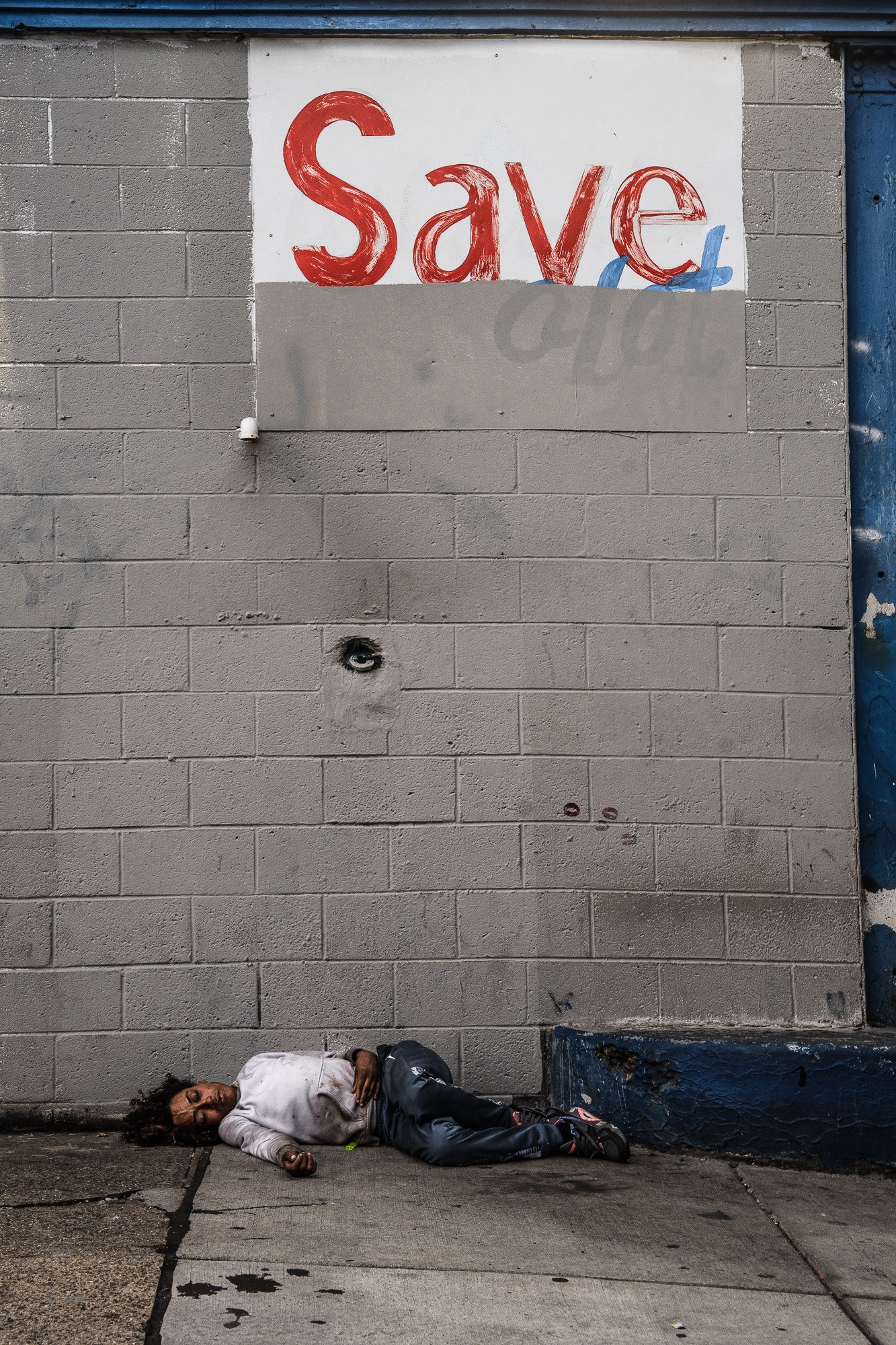 A young woman on Pacific Street in Kensington, Philadelphia, a frequent presence who suddenly disappeared, embodying the precariousness of life on the streets.
A young woman on Pacific Street in Kensington, Philadelphia, a frequent presence who suddenly disappeared, embodying the precariousness of life on the streets.
There were situations I witnessed that remained etched in my memory, too dangerous to photograph. These uncaptured images are among the most powerful and meaningful in my mind. The haunting images of young women walking endlessly along Kensington Avenue, vulnerable and exceptionally difficult to photograph ethically in their street circumstances, linger with me.
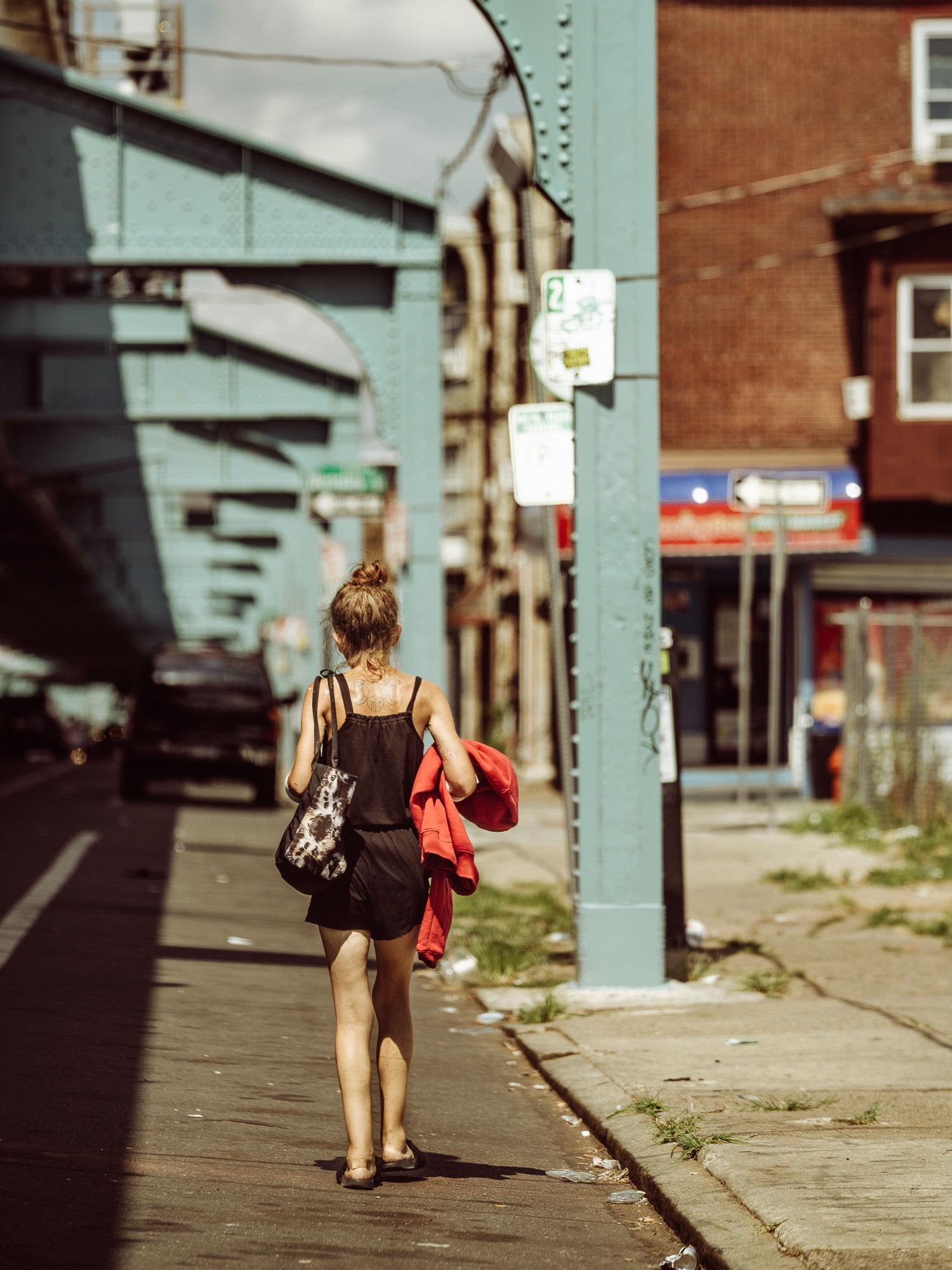 A young woman walking along Kensington Avenue, Philadelphia, representing the vulnerability and challenges faced by women in the area.
A young woman walking along Kensington Avenue, Philadelphia, representing the vulnerability and challenges faced by women in the area.
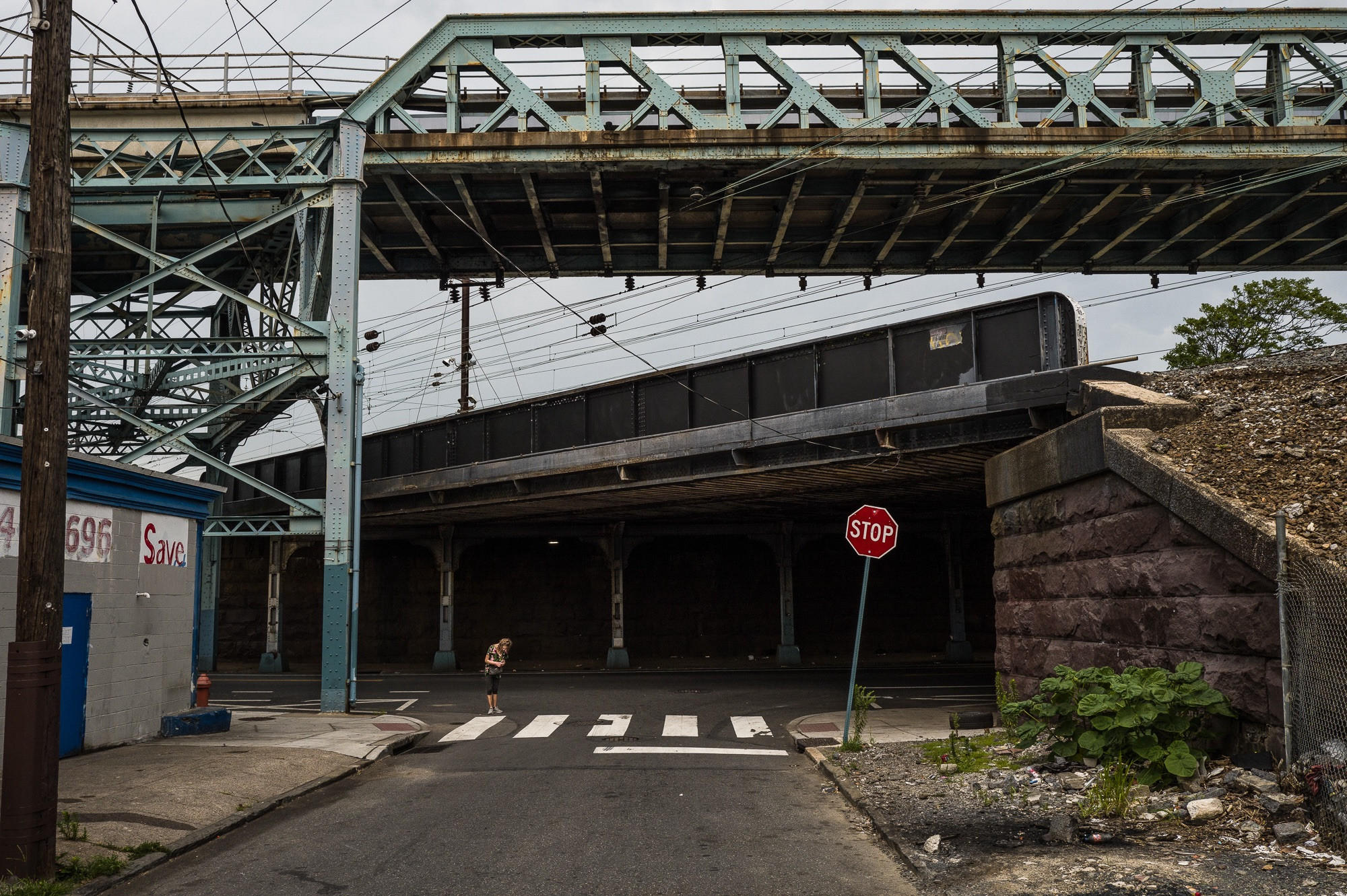 Women seen on Pacific Street in Kensington, Philadelphia, illustrating the area's complex social dynamics and the delicate balance required in street photography.
Women seen on Pacific Street in Kensington, Philadelphia, illustrating the area's complex social dynamics and the delicate balance required in street photography.
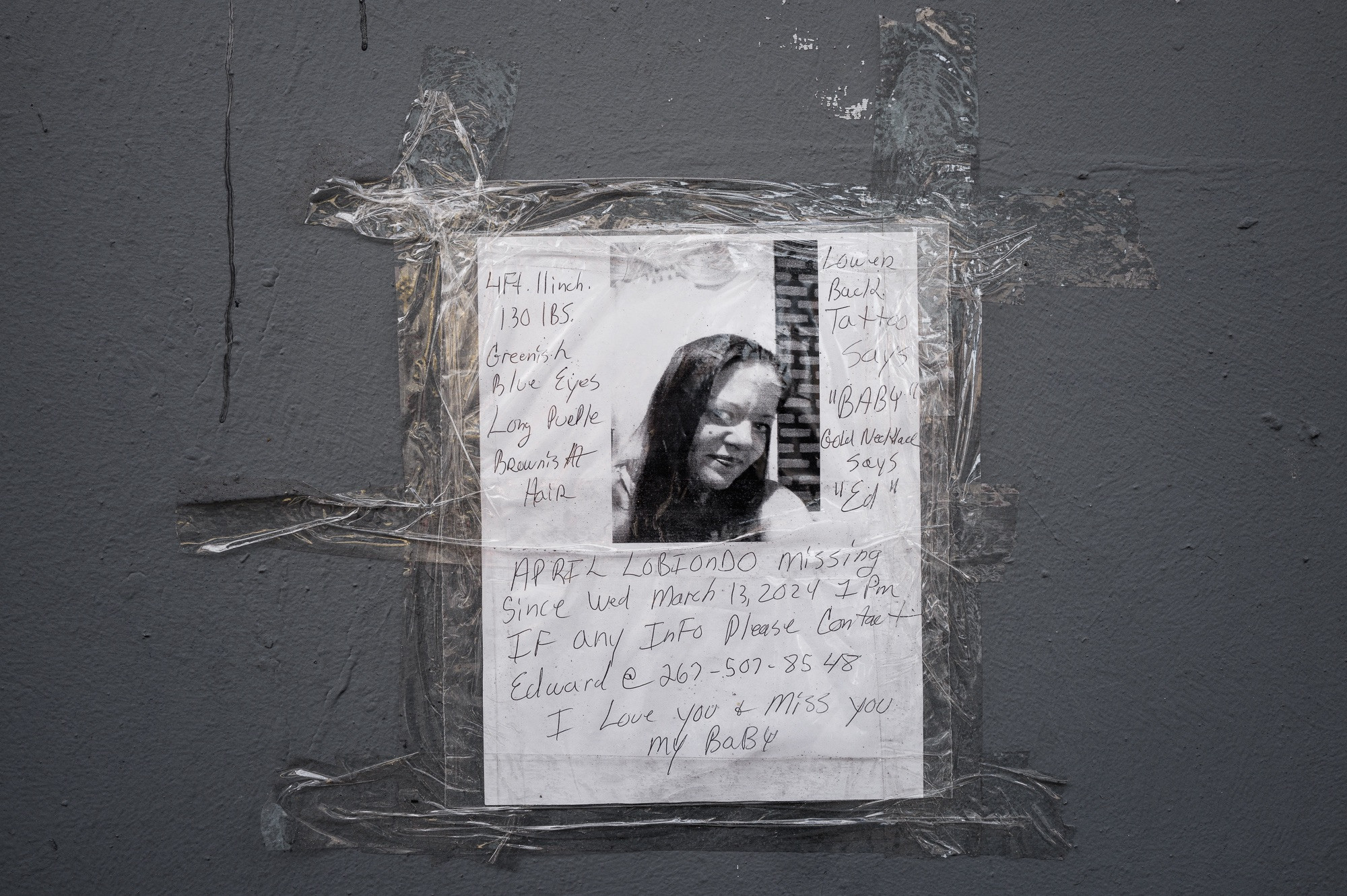 A "Missing" poster in Kensington, Philadelphia, symbolizing the ongoing crisis of disappearances and the fragility of life on the streets.
A "Missing" poster in Kensington, Philadelphia, symbolizing the ongoing crisis of disappearances and the fragility of life on the streets.
I will never forget witnessing a woman near G Street and E. Schiller Street, cradling what appeared to be a lifeless infant. The child, face down, dressed in a light blue striped onesie, limbs dangling without any sign of life, looked tragically emaciated. As she walked, she angrily wailed at a man crossing the street, who recoiled in fear, shouting back as he tried to distance himself from her and the baby. The thought of taking a picture crossed my mind, but the risk felt too great on those narrow, one-way streets, offering little chance of a quick escape if the camera triggered a dangerous reaction. This is just one memory of a scene, an image so fraught that even placing it on my website would be a difficult decision, had I managed to capture it and escape unharmed. I often contemplate the untold stories, the secrets hidden in plain sight in places like Kensington, existing only in memory.
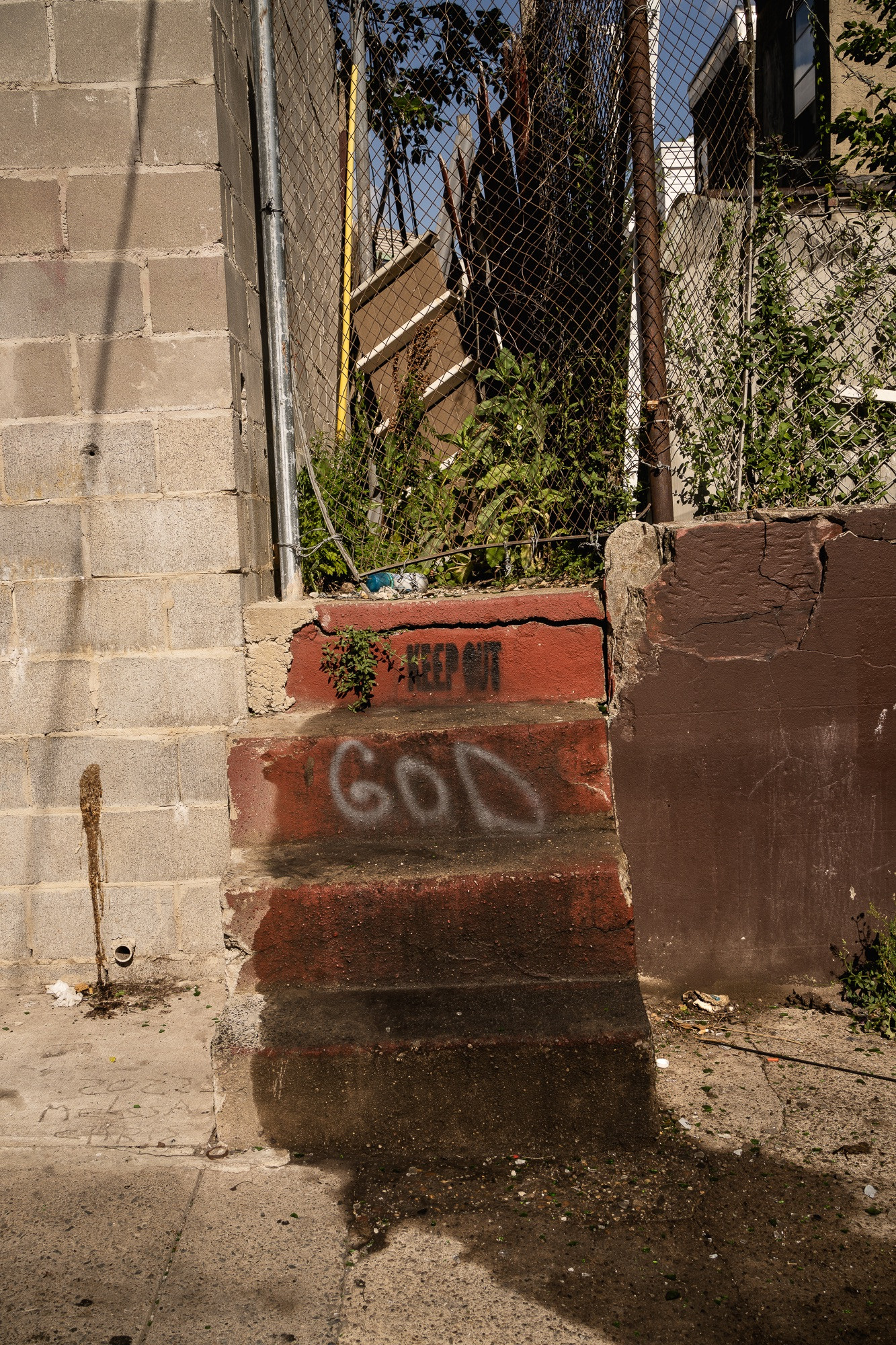 A street scene on B Street in Kensington, Philadelphia, reflecting the everyday reality of the neighborhood.
A street scene on B Street in Kensington, Philadelphia, reflecting the everyday reality of the neighborhood.
Ultimately, I have come to a firm conclusion: public spaces are inherently public. For a photographer, this means that if photographing a festival or a street scene is permissible in any city where photography is legally allowed, then it remains acceptable regardless of the specific geographical area within that legal jurisdiction. I believe Kensington must be photographed. Documenting it effectively is a constant challenge, one I acknowledge I don’t always master. I strive to do my best each time I photograph there. Kensington has, for so long, operated outside conventional norms, leading to a demonization of photography and photographers, perceived as threats of exposure. If individuals are in public, participating in an unfolding story, particularly one marked by disaster and profound significance, then photography falls within the often-debated boundaries of fair practice. Many are exploiting the neighborhood’s unusual freedoms to engage in any behavior, regardless of how harsh, cruel, sad, objectionable, or unlawful it may be. How can this widespread exploitation be deemed off-limits to the scrutiny of a photographer’s lens? If I am witnessing a place operating by its own rules, dictating its own terms, who is truly qualified to dictate which forms of exploitation are more egregious – theirs or mine?
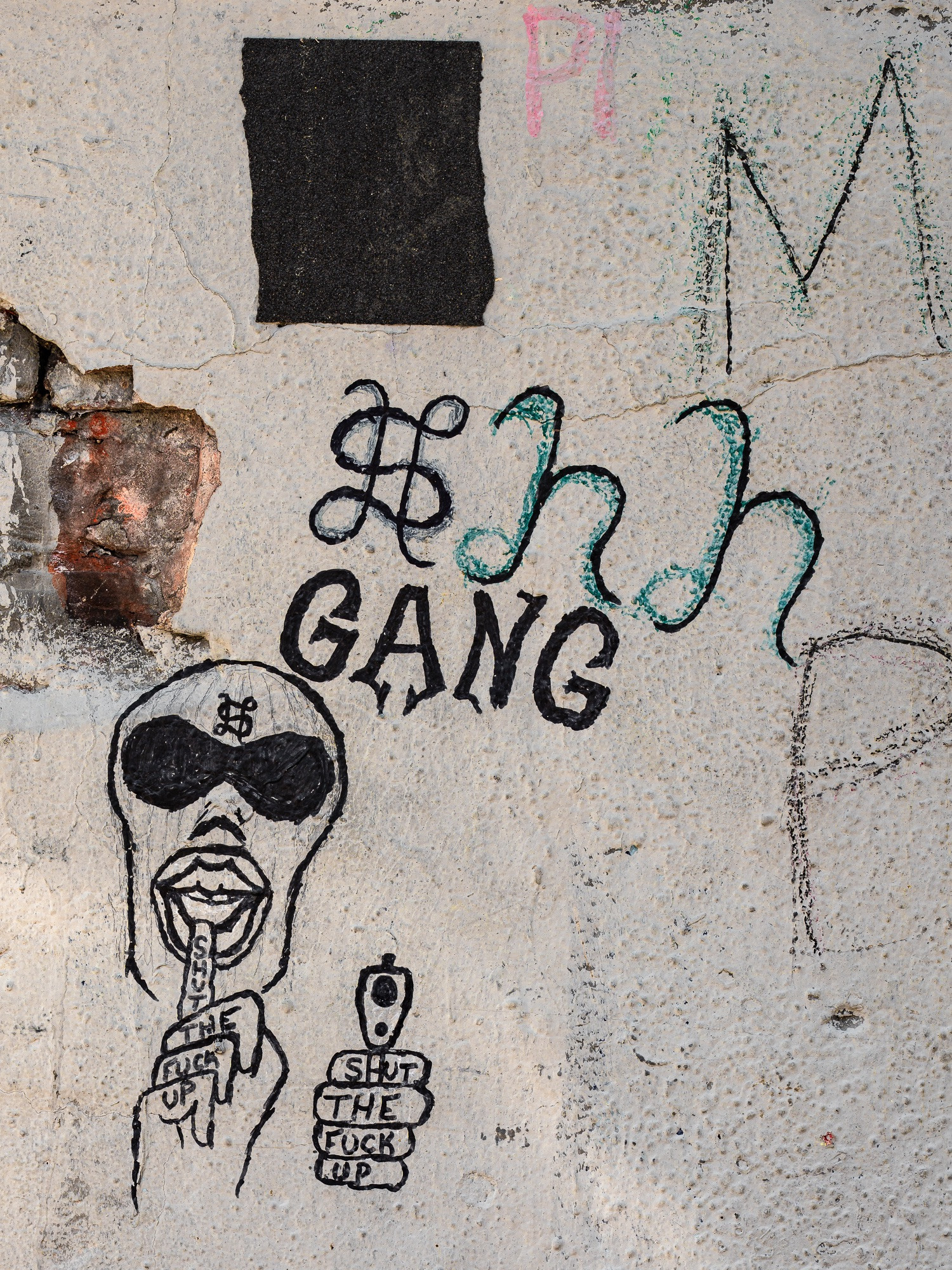 A drug corner near Emerald and Sterner Streets in Kensington, Philadelphia, capturing the open drug activity prevalent in certain areas.
A drug corner near Emerald and Sterner Streets in Kensington, Philadelphia, capturing the open drug activity prevalent in certain areas.

